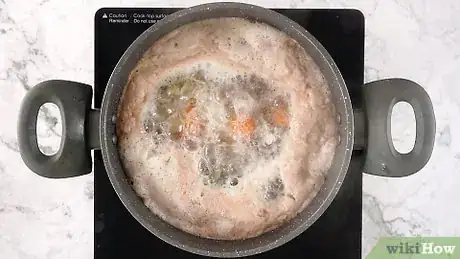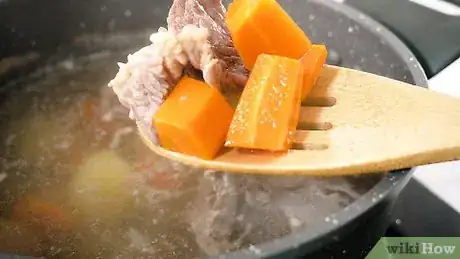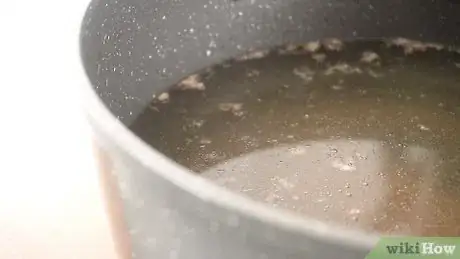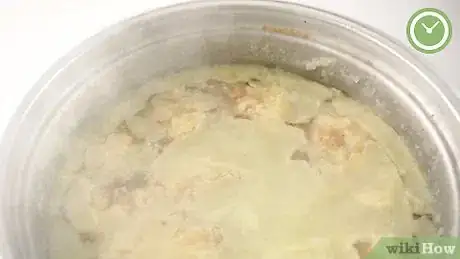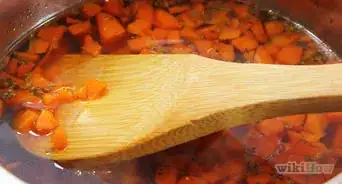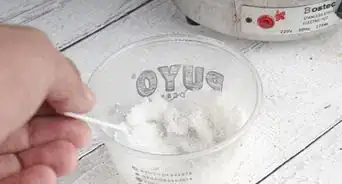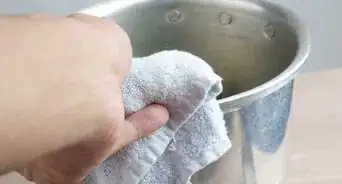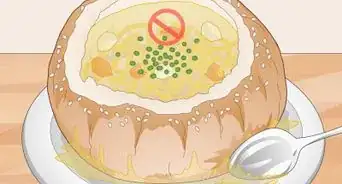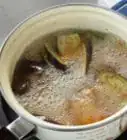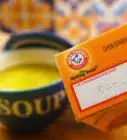This article was co-authored by wikiHow Staff. Our trained team of editors and researchers validate articles for accuracy and comprehensiveness. wikiHow's Content Management Team carefully monitors the work from our editorial staff to ensure that each article is backed by trusted research and meets our high quality standards.
There are 10 references cited in this article, which can be found at the bottom of the page.
The wikiHow Video Team also followed the article's instructions and verified that they work.
This article has been viewed 159,719 times.
Learn more...
Removing the fat from soup and broth can be an essential part of a recipe, or it might be a preference to help you maintain a leaner diet. Skim the soup during the cooking process to get a clearer, leaner broth. Or strain out the broth if you prefer to keep the fat for the cooking process but don’t want to consume it. If you decide to strain your soup, remove the chunks of vegetables, meat, rice, noodles, or bones first so you can strain just the broth. If you’d rather wait until you can remove all of the fat, chill the soup so the fat solidifies. Then it can be easily separated from the lean ingredients. Choose your skimming technique before you start cooking as different techniques require certain tools and timing considerations.
Steps
Simmering Soup
-
1Bring your soup to a gentle simmer on the stove. When you’re ready to skim off the fat, turn the heat down to medium-high so that the soup gently simmers. You’ll start to see the fat particles floating or foaming towards the top of the stockpot. Don’t allow the soup to continue at a rolling boil.[1]
- Boiling soup over high heat melts the fat, meaning it will blend into the broth. This makes it harder to remove.[2]
-
2Stir the liquid so the foaming fat moves to the edges of the stockpot. Submerge a long-handled ladle or wooden spoon into the center of the pot. Stir it around to get the simmering liquid swirling in a circle.[3]
- The stirring movements will cause the oily foam and globules to migrate to the outside edges of the stockpot.
Advertisement -
3Scoop up the foaming fat with a fine mesh skimming utensil. Once the oils start to foam up and float on the top of the soup, dip the edge of the shallow skimming utensil just below the surface of the soup. Then lift it upwards quickly to scoop up the foam and fat.[4] You’ll see some of the foamy fat stuck to the inside of the mesh.
- Continue scooping up the fat until there’s enough collected in the mesh to discard.
- Dunk the mesh skimmer in a bowl of water or rinse it off under running water to remove the fat residue.[5]
- This method works particularly well for skimming chicken stock.
-
4Use the back of a cold metal spoon if you don’t have a mesh skimming utensil. Place a handful of ice cubes into a deep metal spoon or ladle to chill it down. Keep the ice cubes in the spoon while you touch the back of the spoon to the surface of the soup. Glide the back of the spoon gently across the fatty globules. The fat will solidify and stick onto the back of the spoon. Lift up the spoon and discard any fat that’s stuck to the bottom.
- When the cold metal touches the hot soup, the fat that has gathered near the surface will quickly coagulate onto the spoon so you can peel it off.[6]
- Wipe off the fat onto a paper towel and repeat the process to remove all of the fat.
- You must use a metal spoon for this method. A wooden or plastic spoon won’t get as cold.
- Don’t submerge the whole spoon into the soup. Just hold it parallel to the surface of the liquid while the fat gathers on the back of the spoon.
Warm Broth
-
1Remove any vegetables, meat, or noodles before straining the soup. Use a slotted spoon to lift out any meat and veggie chunks, noodles, and rice from thicker soups once the soup has cooked completely. Set these aside in a bowl and cover it. Feel free to leave it at room temperature while you cool and strain the broth.
- If you’re making a bone broth, follow the same process to remove and discard the bones.
- To speed up the separating process, cook the soup with a double-layered pasta pot. Insert the strainer layer before adding your ingredients. Everything will be submerged in the stock while you cook the soup, but you can lift out the inner strainer to remove just the chunky pieces. Allow the stock to drain out into the bottom pot.[7]
-
2Cool the broth until the fat particles just start to solidify. Remove the stockpot from the heat source and allow the soup to cool down slightly, for about 15 to 30 minutes depending on the quantity of soup. Wait until the soup stops bubbling and steaming, and you see the oils float to the top of the stockpot. They don’t need to completely solidify, but you don’t want them to be boiling hot.
- Cooling and straining the broth takes a little extra time. Plan ahead if you’re aiming to have the soup ready by a certain time.
- Leave the soup uncovered as it cools, but don’t stir it around.
-
3Pour the broth through a gravy separator if you want to skim the fat quickly. Once you’re left with just the liquid broth, carefully pour it from the stockpot directly into a fat-separating pitcher known as a gravy separator, a fat separator, or a skimming pitcher. Set the pitcher aside for 5 minutes or until most of the fat has risen to the top of the soup. Then pour the broth back into the stockpot or a serving bowl.[8]
- The liquid should pass through the spout and the fat should remain trapped inside the pitcher.
- These tools can be found at specialty cookware shops and online retailers. They look like a large measuring jug with a spout extending out from the bottom.
- A bottom-draining fat separator works in a similar way. To use this tool, hold the pitcher over the stockpot or a serving bowl. The broth will drain out into the stockpot while the fat stays trapped inside the pitcher.[9]
-
4Strain the broth through a kitchen towel if you don’t have a separator. Soak a clean, plain-weave or cheesecloth kitchen towel in cold water and wring it out so it’s damp but not dripping. Arrange the towel as a lining within a sturdy colander. Place the colander within another stockpot or deep serving bowl. Then, carefully pour the broth through the towel-lined colander and into the pot.[10]
- The fat globules will solidify and stick to the cold towel as the rest of the soup runs into the stockpot.
- Choose a stockpot or serving bowl with plenty of space below the bottom of the colander. If it’s too shallow, the soup will fill up around the colander and it won’t strain properly.
- You can also try this technique with a cold, damp coffee filter instead of a cloth towel.[11]
Chilled Soup
-
1Chill the soup in the refrigerator overnight. Once you’ve finished cooking the soup, remove it from the heat and cover the stockpot with cling wrap or aluminum foil. Allow it to cool down at room temperature for about 10 to 20 minutes, then place it in the refrigerator. Leave it to chill for at least 6 to 8 hours, or until the fat floats to the top and completely hardens.[12]
- Try to prepare your soup the night before so it has time to chill overnight.
- If you need to serve the soup right away, this technique won't be suitable. Try skimming the fat while you’re cooking the soup or straining the broth instead.
-
2Scoop away the solidified fat with a spoon if you’re skimming a thick soup. Once you see a solid layer or solid chunks of light-colored fat solids, they’ll be easy to remove these from the soup. Glide a large spoon underneath the solid pieces of fat and carefully lift them out. Discard the solid fat.
- After removing the fat, reheat the lean soup on the stove or in a microwave before serving it.
- This method works for chunky soups as well as broth.
-
3Pour chilled soup a hole in a plastic bag if you’re skimming broth. Carefully pour the chilled broth from the stockpot into a resealable gallon-sized plastic bag. Seal the top and hold the bag over a serving bowl or another stockpot. Snip off one of the bottom corners of the bag and allow the broth to pour out into the bowl. The fat solids will get stuck in the bag and can be discarded.[13]
- If you have more soup than can fit in the bag, repeat the process with a second bag and discard the first.
- This technique won’t work for thick soups containing meat, vegetables, noodles, or rice. But it’s great for skimming broth.
Community Q&A
-
QuestionHow do you skim soup without a skimmer?
 Drew Hawkins1Community AnswerA skimmer can be super useful, but if you don't have one, no worries. You can still skim the fat off of your soup by straining the broth. First, remove any meat and veggie chunks, noodles, and rice from thicker soups once the soup has cooked completely. Let the broth cool until you can see the fat particles starting to solidify. They don’t need to completely solidify, but you don’t want them to be boiling hot. Then, soak a clean, plain-weave or cheesecloth kitchen towel in cold water and wring it out so it’s damp but not dripping. Arrange the towel as a lining within a sturdy colander. Place the colander within another stockpot or deep serving bowl. Then, carefully pour the broth through the towel-lined colander and into the pot. The fat globules will solidify and stick to the cold towel as the rest of the soup runs into the stockpot. Easy!
Drew Hawkins1Community AnswerA skimmer can be super useful, but if you don't have one, no worries. You can still skim the fat off of your soup by straining the broth. First, remove any meat and veggie chunks, noodles, and rice from thicker soups once the soup has cooked completely. Let the broth cool until you can see the fat particles starting to solidify. They don’t need to completely solidify, but you don’t want them to be boiling hot. Then, soak a clean, plain-weave or cheesecloth kitchen towel in cold water and wring it out so it’s damp but not dripping. Arrange the towel as a lining within a sturdy colander. Place the colander within another stockpot or deep serving bowl. Then, carefully pour the broth through the towel-lined colander and into the pot. The fat globules will solidify and stick to the cold towel as the rest of the soup runs into the stockpot. Easy! -
QuestionHow do you skim fat when cooking?
 Drew Hawkins1Community AnswerSkimming the fat off of soup while it's still cooking is one of the easiest ways to do it! Start by bringing your soup to a gentle simmer on the stove. When you’re ready to skim off the fat, turn the heat down to medium-high so that the soup gently simmers. You’ll start to see the fat particles floating or foaming towards the top of the stockpot. Then, stir the liquid so the foaming fat moves to the edges of the stockpot. Once the oils start to foam up and float on the top of the soup, dip the edge of a fine mesh skimming utensil just below the surface of the soup and scoop out the fatty foam. Continue scooping up the fat until there’s enough collected in the mesh to discard. That's all there is to it!
Drew Hawkins1Community AnswerSkimming the fat off of soup while it's still cooking is one of the easiest ways to do it! Start by bringing your soup to a gentle simmer on the stove. When you’re ready to skim off the fat, turn the heat down to medium-high so that the soup gently simmers. You’ll start to see the fat particles floating or foaming towards the top of the stockpot. Then, stir the liquid so the foaming fat moves to the edges of the stockpot. Once the oils start to foam up and float on the top of the soup, dip the edge of a fine mesh skimming utensil just below the surface of the soup and scoop out the fatty foam. Continue scooping up the fat until there’s enough collected in the mesh to discard. That's all there is to it! -
QuestionShould you skim fat off soup?
 Drew Hawkins1Community AnswerIt's depends on what you're cooking and whether or not you want to lower the fat content of your soup. Some recipes require you to remove the fat from soup and broth. Skimming the soup also makes it leaner and healthier. So if you're on a low-cholesterol or low-fat diet, it's a simple way to make a soup follow your dietary guidelines. It also produces a lighter broth, which can be better for certain types of soup. There are also other benefits of skimming the fat off of soup. You can save and reuse the fat for cooking just like you would use lard or bacon grease. It's also helpful to skim the fat if you're making stock because it'll help preserve the flavors in the broth.
Drew Hawkins1Community AnswerIt's depends on what you're cooking and whether or not you want to lower the fat content of your soup. Some recipes require you to remove the fat from soup and broth. Skimming the soup also makes it leaner and healthier. So if you're on a low-cholesterol or low-fat diet, it's a simple way to make a soup follow your dietary guidelines. It also produces a lighter broth, which can be better for certain types of soup. There are also other benefits of skimming the fat off of soup. You can save and reuse the fat for cooking just like you would use lard or bacon grease. It's also helpful to skim the fat if you're making stock because it'll help preserve the flavors in the broth.
Things You’ll Need
Skimming Fat from Simmering Soup
- Long-handled ladle or wooden spoon
- Fine mesh skimming utensil
- Metal ladle
Straining Warm Broth
- Slotted spoon
- Double-layered pasta pot
- Gravy separator
- Kitchen towel
- Colander
- Coffee filter
Removing Fat from Chilled Soup
- Refrigerator
- Cling wrap or aluminum foil
- Spoon
- Gallon-sized plastic bag
References
- ↑ https://www.saveur.com/article/Techniques/Skimming-101/
- ↑ https://www.justonecookbook.com/how-to-skim-off-the-scum-and-fat-from-soups-and-stocks/
- ↑ https://www.saveur.com/article/Techniques/Skimming-101/
- ↑ https://youtu.be/29hlcJlwtWM?t=35
- ↑ https://www.justonecookbook.com/how-to-skim-off-the-scum-and-fat-from-soups-and-stocks/
- ↑ http://www.saveur.com/article/Techniques/Skimming-101
- ↑ https://youtu.be/61PqmjDNYqg?t=31
- ↑ https://www.cooksillustrated.com/how_tos/5805-three-ways-to-separate-and-skim-fat
- ↑ https://www.cooksillustrated.com/articles/344-testing-fat-separators
About This Article
To skim off the fat while you’re cooking soup, bring the soup to a gentle simmer over medium-high heat. Don’t let it boil heavily, since this will cause the fat to melt and break up. The fat should start to foam up and make a froth on top of the soup. Stir the center of the broth with a wooden spoon so that the foam moves to the edges of the pot. Then, use a fine mesh skimming utensil to scoop the frothy fat out of the pot. If you don’t have a skimmer, put some ice cubes in a large metal ladle or stirring spoon and skim the back of the cold spoon over the surface of the soup so that the fat sticks to it. Read on to learn how to strain warm broth after it’s cooked!
